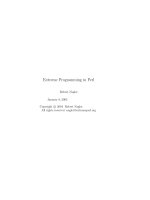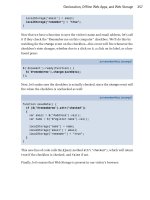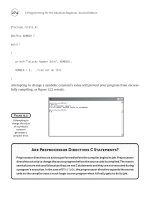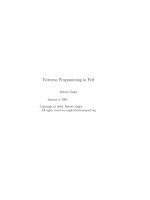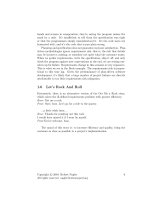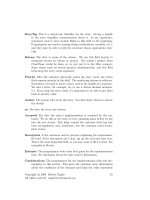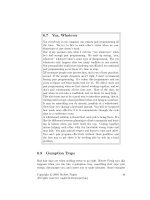Extreme Programming in Perl Robert Nagler phần 10 pps
Bạn đang xem bản rút gọn của tài liệu. Xem và tải ngay bản đầy đủ của tài liệu tại đây (179.11 KB, 25 trang )
program tells you what to do.”
12
When we apply this analogy to the example, we see that to html tags imperatively
tells us it formats tag names one at a time, and it appends them to the end
of a string. When its done with that, it’ll return the result.
The functional to html tags has a list of tag names and wants a string
to return, so it asks join, a function that conatenates a list into a string.
join asks for a separator and a list of tags to concatenate. map wants to
format tag names, so it asks for a formatter ({"<$prefix$ >"}) and a list
of tag names.
All we’re missing is some polite phrases like please and may I, and we
can expand this analogy to familial relationships. Imperative kids tell their
parents, “I’m taking the car.” Declarative kids politely ask, “May I bor-
row the car, please?”. By communicating their desires instead of demands,
declarative kids give their parents more leeway to implement their requests.
Pure functions, and declarative programs in general, are more flexible
than their imperative cousins. Instead of demanding a calling order that is
implicitly glued together with state (variables), declarative programs define
relationships syntactically. This reduces the problem of refactoring from an
implicit global problem of maintaining state transitions to an explicit lo cal
one of preserving syntactic relationships. Functional programs are easier to
refactor.
15.16 Second Task
The second task introduces asymmetric output. The test case input file
(02.html) is:
<chapter>
<title>Chapter with Epigraph</title>
<epigraph>
<para>
Representation <emphasis>is</emphasis> the essence of programming.
</para> <attribution>Fred Brooks</attribution>
</epigraph>
<simplesect>
<para>Some Text</para>
</simplesect>
</chapter>
12
On Lisp, Paul Graham, p. 33.
Copyright
c
2004 Robert Nagler
All rights reserved
156
The output file (02.xml) we expect is:
<html><body>
<h1>Chapter with Epigraph</h1>
<p>
Representation <b>is</b> the essence of programming.
</p> <div align=right> Fred Brooks</div>
<p>Some Text</p>
</body></html>
The XML attribute tag doesn’t map to a simple HTML div tag, so the
existing SMOP language didn’t work. But first we had to update the unit
test.
15.17 Unit Test Maintenance
To add the new case to the unit test, we copied the line containing the first
test case, and changed the the filenames:
#!perl -w
use strict;
use Bivio::Test;
use Bivio::IO::File;
Bivio::Test->new(’Bivio::XML::DocBook’)->unit([
’Bivio::XML::DocBook’ => [
to_html => [
[’DocBook/01.xml’] => [Bivio::IO::File->read(’DocBook/01.html’)],
[’DocBook/02.xml’] => [Bivio::IO::File->read(’DocBook/02.html’)],
],
],
]);
Copyright
c
2004 Robert Nagler
All rights reserved
157
Woops! We fell into the dreaded copy-and-paste trap. The new line is
identical to the old except for two characters out of 65. That’s too much
redundancy (97% fat and 3% meat). It’s hard to tell the difference between
the two lines, and as we add more tests it will be even harder. This makes
it easy to forget to add a test, or we might copy-and-paste a line and forget
to change it.
We factored out the common code to reduce redundancy:
#!perl -w
use strict;
use Bivio::Test;
use Bivio::IO::File;
Bivio::Test->new(’Bivio::XML::DocBook’)->unit([
’Bivio::XML::DocBook’ => [
to_html => [ map({ my($html) = $ ; $html =~ s/xml$/html/; [$ ]
=> [Bivio::IO::File->read($html)]; } sort(<DocBook/*.xml>))
],
],
]);
This version of the unit test is maintenance free. The test converts all
.xml files in the DocBook subdirectory. All we need to do is declare them,
i.e., create the .xml and .html files. We can execute the cases in any order,
so we chose to sort them to ease test case identification.
15.18 Second SM OP
We extended the SMOP grammar to accommodate asymmetric output. The
new mappings are shown below:
my($_TO_HTML) = to html compile({ attribution => { prefix => ’<div
align=right> ’, suffix => ’</div>’, },
chapter => [’html’, ’body’], emphasis => [’b’], epigraph => [],
para => [’p’],
simplesect => [],
title => [’h1’],
Copyright
c
2004 Robert Nagler
All rights reserved
158
});
attribution maps to a hash that defines the prefix and suffix. For the
other tags, the prefix and suffix is computed from a simple name. We added
to html compile which is called once at initialization to convert the simple
tag mappings (arrays) into the more general prefix/suffix form (hashes) for
efficiency.
15.19 Second SM OP Interpreter
We extended to html node to handle asymmetric prefixes and suffixes. The
relevant bits of code are:
sub to html compile { my($config) = @ ; while (my($xml, $html)
= each(%$config)) { $config->{$xml} = { prefix => to html tags($html,
’’), suffix => to html tags([reverse(@$html)], ’/’), } if ref($html)
eq ’ARRAY’; } return $config; }
sub _to_html_node {
my($tag, $tree) = @_;
return HTML::Entities::encode($tree)
unless $tag;
die($tag, ’: unhandled tag’)
unless $_TO_HTML->{$tag};
# We ignore the attributes for now.
shift(@$tree);
return $ TO HTML->{$tag}->{prefix} . ${ to html($tree)} . $ TO HTML->{$tag}->{suffix};
}
to html compile makes to html node simpler and more efficient, because
it no longer calls to html tags with the ordered and reversed HTML tag
name lists. Well, I thought it was more efficient. After performance tes ting,
the version in Final Implementation turned out to be just as fast.
13
The unnecessary compilation step adds complexity without improving
performance. We added it at my insistence. I remember saying to Alex,
13
Thanks to Greg Compestine for asking the questions: What are the alternatives, and
how do you know is faster?
Copyright
c
2004 Robert Nagler
All rights reserved
159
“We might as well add the compilation step now, since we’ll need it later
anyway.” Yikes! Bad programmer! Write “I’m not going to need it” one
hundred times in your PDA. Even in pairs, it’s hard to avoid the evils of
pre-optimization.
15.20 Spike Solutions
As long as I am playing true confessions, I might as well note that I imple-
mented a spike solution to this problem be fore involving my programming
partners. A spike solution in XP is a prototype that you intend to throw
away. I wrote a spike to see how easy it was to translate DocBook to HTML.
Some of my partners knew about it, but none of them saw it.
The spike solution affected my judgement. It had a compilation s tep,
too. Programming alone led to the pre-optimization. I was too confident
that it was necessary when pairing with Alex.
Spike solutions are useful, despite my experience in this c ase . You use
them to shore up confidence in estimates and feasibility of a story. You write
a story card for the spike, which estimates the cost to research possibilities.
Spike solutions reduce risk through exploratory programming.
15.21 Third Task
The third task introduces contextually related XML tags. The DocBook
title tag is interpreted differently depending on its enclosing tag. The test
case input file (03.xml) is:
<chapter> <title>Chapter with Section Title</title>
<simplesect>
<programlisting>
print(values(%{{1 8}}));
</programlisting>
<para>
Some other tags:
<literal>literal value</literal>,
<function>function_name</function>, and
<command>command-name</command>.
</para>
Copyright
c
2004 Robert Nagler
All rights reserved
160
<blockquote><para>
A quoted paragraph.
</para></blockquote>
</simplesect>
<sect1> <title>Statelessness Is Next to Godliness</title>
<para>
A new section.
</para>
</sect1>
</chapter>
The expected output file (03.html) is:
<html><body> <h1>Chapter with Section Title</h1>
<blockquote><pre>
print(values(%{{1 8}}));
</pre></blockquote>
<p>
Some other tags:
<tt>literal value</tt>,
<tt>function_name</tt>, and
<tt>command-name</tt>.
</p>
<blockquote><p>
A quoted paragraph.
</p></blockquote>
<h2>Statelessness Is Next to Godliness</h2>
<p>
A new section.
</p>
</body></html>
Copyright
c
2004 Robert Nagler
All rights reserved
161
The chapter title translates to an HTML h1 tag. The section title
translates to an h2 tag. We extended our SMOP language to handle these
two contextually different renderings of title.
15.22 Third SMOP
We discussed a number of ways to declare the contextual relationships in our
SMOP. We could have added a parent attribute to the hashes (on the right)
or nested title within a hash pointed to by the chapter tag. The syntax
we settled on is similar to the one used by XSLT.
14
The XML tag names can
be prefixed with a parent tag name, for example, "chapter/title". The
SMOP became:
my($ XML TO HTML PROGRAM) = compile program({
attribution => {
prefix => ’<div align=right> ’,
suffix => ’</div>’,
}, blockquote => [’blockquote’], ’chapter/title’ => [’h1’],
chapter => [’html’, ’body’], command => [’tt’],
emphasis => [’b’],
epigraph => [], function => [’tt’], literal => [’tt’],
para => [’p’], programlisting => [’blockquote’, ’pre’], sect1
=> [], ’sect1/title’ => [’h2’],
simplesect => [],
});
15.23 Third SMOP Interpreter
We refactored the code a bit to encapsulate the contextual lookup in its own
subroutine:
sub to_html {
my($self, $xml_file) = @_;
14
The XML Stylesheet Language Translation is an XML programming language for
translating XML into XML and other output formats (e.g., PDF and HTML). For more
info, see />Copyright
c
2004 Robert Nagler
All rights reserved
162
return _to_html( ’’,
XML::Parser->new(Style => ’Tree’)->parsefile($xml_file));
}
sub eval child {
my($tag, $children, $parent tag) = @_;
return HTML::Entities::encode($children)
unless $tag;
# We ignore the attributes for now.
shift(@$children);
return eval op( lookup op($tag, $parent tag), to html($tag, $children));
}
sub eval op { my($op, $html) = @ ; return $op->{prefix} . $$html
. $op->{suffix}; } sub lookup op { my($tag, $parent tag) = @ ; return
$ XML TO HTML PROGRAM->{"$parent tag/$tag"} || $ XML TO HTML PROGRAM->{$tag}
|| die("$parent tag/$tag: unhandled tag"); }
sub _to_html {
my($tag, $children) = @_;
my($res) = ’’;
$res .= eval child(splice(@$children, 0, 2), $tag)
while @$children;
return \$res;
}
# Renamed compile program and compile tags to html not shown for
brevity.
The algorithmic change is centralized in lookup op, which wants a tag
and its parent to find the correct relation in the SMOP. Precedence is given
to contextually related tags ("$parent tag/$tag") over simple XML tags
($tag). Note that the root tag in to html is the empty string (’’). We
defined it to avoid complexity in the lower layers. lookup op need not be
specially coded to handle the empty parent tag case.
15.24 The Metaphor
This task implementation includes several name changes. Alex didn’t feel
the former names were descriptive enough, and they lacked coherency. To
Copyright
c
2004 Robert Nagler
All rights reserved
163
help think up good names, Alex suggested that our program was similar
to a compiler, because it translates a high-level language (DocBook) to a
low-level language (HTML).
We refactored the names to reflect this new metaphor. $ TO HML became
$ XML TO HTML PROGRAM, and to html compile to compile program. and
so on. An $op is the implementation of an operator, and lookup op parallels
a compiler’s symbol table lookup. eval child evokes a c ompiler’s recursive
descent algorithm.
The compiler metaphor helpe d guide our new name choices. In an
XP project, the metaphor subsitutes for an architectural overview docu-
ment. Continuous design means that the architecture evolves with each
iteration, sometimes dramatically, but a project still needs to be coherent.
The metaphor brings consistency without straitjacketing the implementa-
tion. In my opinion, you don’t need a metaphor at the start of a project.
Too little is known about the code or the problem. As the code base grows,
the metaphor may present itself naturally as it did here.
15.25 Fourth Task
The fourth and final task introduces state to generate the HTML for Doc-
Book footnotes. The test case input file (04.xml) is:
<chapter>
<title>Chapter with Footnotes</title>
<simplesect>
<para>
Needs further clarification. <footnote><para> Should appear at the
end of the chapter. </para></footnote>
</para>
<itemizedlist>
<listitem><para>
First item
</para></listitem>
<listitem><para>
Second item
</para></listitem>
</itemizedlist>
Copyright
c
2004 Robert Nagler
All rights reserved
164
<para>
Something about XML. <footnote><para> Click here <systemitem role="url"> /></para></footnote>
</para>
<para>
<classname>SomeClass</classname>
<varname>$some_var</varname>
<property>a_property</property>
<filename>my/file/name.PL</filename>
<citetitle>War & Peace</citetitle>
<quote>I do declare!</quote>
</para>
</simplesect>
</chapter>
The expected output file (04.html) is:
<html><body>
<h1>Chapter with Footnotes</h1>
<p>
Needs further clarification. <a href="#1">[1]</a>
</p>
<ul>
<li><p>
First item
</p></li>
<li><p>
Second item
</p></li>
</ul>
<p>
Something about XML. <a href="#2">[2]</a>
Copyright
c
2004 Robert Nagler
All rights reserved
165
</p>
<p>
<tt>SomeClass</tt>
<tt>$some_var</tt>
<tt>a_property</tt>
<tt>my/file/name.PL</tt>
<i>War & Peace</i>
"I do declare!"
</p>
<h2>Footnotes</h2><ol> <li><a name="1"></a><p> Should appear at
the end of the chapter. </p></li> <li><a name="2"></a><p> Click
here <a href=" /></p></li> </ol>
</body></html>
The footnotes are compiled at the end in a Footnotes section. Each foot-
note is linked through HTML anchor tags (#1 and #2). Incremental indexes
and relocatable output were the new challenges in this implementation.
15.26 Fourth SMOP
We pulled another blade out of our Swiss Army chainsaw for this task. Perl’s
anonymous subroutines were used to solve the footnote problem. The sub-
routines bound to chapter and footnote use variables to glue the footnotes
to their indices and the footnotes section to the end of the chapter. Here
are the additions to the SMOP:
chapter => sub { my($html, $clipboard) = @ ; $$html .= "<h2>Footnotes</h2><ol>\n$clipboard->{footnotes}</ol>\n"
if $clipboard->{footnotes}; return "<html><body>$$html</body></html>";
}, citetitle => [’i’], classname => [’tt’], footnote => sub { my($html,
$clipboard) = @ ; $clipboard->{footnote idx}++; $clipboard->{footnotes}
.= qq(<li><a name="$clipboard->{footnote idx}"></a>$$html</li>\n);
return qq(<a href="#$clipboard->{footnote idx}">) . "[$clipboard->{footnote idx}]</a>";
}, itemizedlist => [’ul’], listitem => [’li’], property => [’tt’],
quote => { prefix => ’"’, suffix => ’"’, }, systemitem => sub {
my($html) = @ ; return qq(<a href="$$html">$$html</a>); }, varname
=> [’tt’],
Copyright
c
2004 Robert Nagler
All rights reserved
166
We didn’t see a simple functional solution. Although it’s certainly possi-
ble to avoid the introduction of $clipboard, we let laziness win out over
dogma. There was no point in smashing our collective head against a brick
wall when an obvious solution was staring right at us. Besides, you’ve got
enough functional programming examples already, so you can stop standing
on your head and read this code right side up.
15.27 Fourth SMOP Interpreter
The interpreter changed minimally:
sub to_html {
my($self, $xml_file) = @_;
return _to_html(
’’,
XML::Parser->new(Style => ’Tree’)->parsefile($xml_file), {});
}
sub _eval_op {
my($op, $html, $clipboard) = @_; return $op->($html, $clipboard)
if ref($op) eq ’CODE’;
return $op->{prefix} . $$html . $op->{suffix};
}
$clipboard is initialized as a reference to an empty hash by to html. If
$op is a CODE reference, eval op invokes the subroutine with $clipboard
and the html generated by the children of the current tag. The anonymous
subroutines bound to the tags can then use all of Perl to fulfill their mapping
obligation.
15.28 Object-Oriented Programming
$clipboard is a reference to a simple hash. An alternative solution would
be to instantiate Bivio::DocBook::XML, and to store footnote idx and
footnotes in its object fields.
Objects are very useful, but they would be overkill here. To instantiate
Copyright
c
2004 Robert Nagler
All rights reserved
167
Bivio::DocBook::XML in Perl, it’s traditional to declare a factory method
called new to construct the object. This would clutter the interface with
another method. We also have the option in Perl to bless a hash reference
inline to instantiate the object. In either case, an objectified hash reference is
more complex than a simple hash, and does not add value. The semantics are
not attached to the hash but are embedded in the anonymous subroutines.
Objects as simple state containers are unnecessarily complex.
Additionally, object field values are less private than those stored in
$clipboard. An object has fields to enable communication between exter-
nal calls, for example, a file handle has an internal buffer and an index so
that successive read calls know what to return. However, it’s common to
abuse object fields for intra-call communication, just like global variables are
abused in structured languages (C, FORTRAN, Pascal, etc.). In most pure
object-oriented languages, there’s no practical alternative to object fields to
pass multiple temporary values to private methods. Choice is one of Perl’s
strengths, and a simple hash localizes the tem porary variable references to
the subroutines that need them.
Hashes and lists are the building blocks of functional programming. Perl
and most functional languages include them as primitive data types. It’s
the simple syntax of a Perl hash that makes the SMOPs in this chapter easy
to read. In many languages, constructing and using a hash is cumbersome,
and SMOP languages like this one are unnatural and hard to read, defeating
their purpose.
In object-oriented programming, state and function are inextricably bound
together. Encapsulating state and function in objects is useful. However, if
all you’ve got is a hammer, every problem looks like a nail. In functional
programming, state and function are distinct entities. Functional languages
decouple function reuse from state sharing, giving programmers two inde-
pendent tools instead of one.
15.29 Success!
The first iteration is complete. We added all the business value the customer
has asked for. The customer can translate a complete chapter. Time for a
victory dance! Yeeha!
Now sit down and stop hooting. We’re not through yet. The customer
gave us some time to clean up our code for this book. It’s time for a little
refactoring. We missed a couple of things, and the code could be more
functional.
Copyright
c
2004 Robert Nagler
All rights reserved
168
15.30 Virtual Pair Programming
The second iteration evolved from some review comments by Stas. I wran-
gled him into partnering with me after he suggested the code could be more
functional. The one hitch was that Stas lives in Australia, and I live in the
U.S.
Pair programming with someone you’ve never met and who lives on
the other side of the world is challenging. Stas was patient with me, and
he paired remotely before.
15
His contribution was worth the hassle, and I
learned a lot from the experience. The fact that he lived in Australia was
an added bonus. After all, he was already standing on his head from my
perspective, and he was always a day ahead of me.
15
Stas Bekman co-wrote the book Practical mod perl with Eric Cholet who lives in
France. Stas is also an active contributor to the mod perl code base and documentation (
).
Copyright
c
2004 Robert Nagler
All rights reserved
169
15.31 Open Source Development with XP
Correspondence coding is quite common. Many open source
projects, such as GNU, Apache, and Linux, are developed by peo-
ple who live apart and sometimes have never met, as was the case
with Stas and me. Open source development is on the rise as
result of our increased communications capabilities. The Internet
and the global telecommunication network enables us to practice
XP remotely almost as easily as we can locally.
Huge collective repositories, such as
and , enable geographically challenged
teams to share code as easily as groups of developers working
in the same building. Sometimes it’s easier to share on the Inter-
net than within some corporate development environments I’ve
worked in! Open source encourages developers to program ego-
lessly. You have to expect feedback when you share your code.
More importantly, open source projects are initiated, are used,
and improve, because a problem needs to be solved, often quickly.
Resources are usually limited, so a simple story is all that is re-
quired to begin development.
Open source and XP are a natural fit. As I’ve noted before, Perl–
one of the oldest open source projects–shares many of XP’s values.
CPAN is Perl’s collective repository. Testing is a core practice in
the Perl community. Simplicity is what makes Perl so accessible
to beginners. Feedback is what makes Perl so robust. And so on.
Open source customers may not speak in one voice, so you need
to listen to them carefully, and unify their requests. But, pair
programming is possible with practice.
Geographically challenged programmers can communicate as ef-
fectively as two programmers sitting at the same computer. It’s
our attitude that affects the quality of the communication. Stas
and I wanted to work together, and we communicated we ll despite
our physical separation and lack of common experience. Open
source works for the same reason: programmers want it to.
To learn more about the open source development, read the book
Open Sources: Voices from the Open Source Revolution, edited
by Chris DiBona et al. available in paperback and also online at
/>Copyright
c
2004 Robert Nagler
All rights reserved
170
15.32 Deviance Testing
We forgot to test for deviance in the prior iteration. XML::Parser handles
missing or incomplete tags, so we don’t need to test for them here. The
unit test should avoid testing other APIs to keep the overall test suite size
as small as possible. However, XML::Parser treats all tags e qually, and
Bivio::XML::DocBook should die if a tag is not in the SMOP. We added
the following test (05-dev.xml) to validate this case :
<chapter>
<unknowntag></unknowntag>
</chapter>
The case tests that lookup op throws an exception when it encounters
unknowntag.
The unit test had to change to expect a die for deviance cases. We also
made the code more functional:
#!perl -w
use strict;
use Bivio::Test;
use Bivio::IO::File;
Bivio::Test->new(’Bivio::XML::DocBook’)->unit([
’Bivio::XML::DocBook’ => [
to_html => [ map({ ["$ .xml"] => $ =~ /dev/ ? Bivio::DieCode->DIE
: [Bivio::IO::File->read("$ .html")]; } sort(map(/(.*)\.xml$/, <DocBook/*.xml>))),
],
],
]);
The map inside the sort returns the case base names (DocBook/01, DocBook/05-dev,
etc.), and the outer map reconstructs the filenames from them. This purely
functional solution is shorter than the previous version.
If the case file name matches the /dev/ regular expression, the map
declares the deviance case by returning a Bivio::DieCode as the expected
value. Otherwise, the input file is conformant, and the map returns the
expected HTML wrapped in an array.
Bivio::Test lets us declare deviance and conformance cases similarly.
Copyright
c
2004 Robert Nagler
All rights reserved
171
When picking or building your test infrastructure, make sure deviance case
handling is built in. If it’s hard to test APIs that die, you’ll probably write
fewer tests for the many error branches in your code.
15.33 Final Implementation
The final SMOP and interpreter are shown together with comments, and
POD, and changes highlighted:
package Bivio::XML::DocBook;
use strict;
our($VERSION) = sprintf(’%d.%02d’, q$Revision: 1.10 $ =~ /\d+/g);
=head1 NAME
Bivio::XML::DocBook - converts DocBook XML files to HTML
=head1 SYNOPSIS
use Bivio::XML::DocBook;
my($html_ref) = Bivio::XML::DocBook->to_html($xml_file);
=head1 DESCRIPTION
C<Bivio::XML::DocBook> converts DocBook XML files to HTML. The mapping is only
partially implemented. It’s good enough to convert a simple chapter.
=cut
#=IMPORTS
use Bivio::IO::File ();
use HTML::Entities ();
use XML::Parser ();
#=VARIABLES
my($_XML_TO_HTML_PROGRAM) = {
attribution => {
prefix => ’<div align="right"> ’,
suffix => ’</div>’,
Copyright
c
2004 Robert Nagler
All rights reserved
172
},
blockquote => [’blockquote’],
’chapter/title’ => [’h1’],
chapter => sub {
my($html, $clipboard) = @_;
$$html .= "<h2>Footnotes</h2><ol>\n$clipboard->{footnotes}</ol>\n"
if $clipboard->{footnotes};
return "<html><body>$$html</body></html>";
},
citetitle => [’i’],
classname => [’tt’],
command => [’tt’],
emphasis => [’b’],
epigraph => [],
filename => [’tt’],
footnote => sub {
my($html, $clipboard) = @_;
$clipboard->{footnote_idx}++;
$clipboard->{footnotes}
.= qq(<li><a name="$clipboard->{footnote_idx}"></a>$$html</li>\n);
return qq(<a href="#$clipboard->{footnote_idx}">)
. "[$clipboard->{footnote_idx}]</a>";
},
function => [’tt’],
itemizedlist => [’ul’],
listitem => [’li’],
literal => [’tt’],
para => [’p’],
programlisting => [’blockquote’, ’pre’],
property => [’tt’],
quote => {
prefix => ’"’,
suffix => ’"’,
},
sect1 => [],
’sect1/title’ => [’h2’],
simplesect => [],
systemitem => sub {
my($html) = @_;
return qq(<a href="$$html">$$html</a>);
Copyright
c
2004 Robert Nagler
All rights reserved
173
},
varname => [’tt’],
};
=head1 METHODS
=cut
=for html <a name="to_html"></a>
=head2 to_html(string xml_file) : string_ref
Converts I<xml_file> from XML to HTML. Dies if the XML is not well-formed or
if a tag is not handled by the mapping. See the initialization of
$_XML_TO_HTML_PROGRAM for the list of handled tags.
=cut
sub to_html {
my($self, $xml_file) = @_;
return _to_html(
’’,
XML::Parser->new(Style => ’Tree’)->parsefile($xml_file),
{});
}
#=PRIVATE SUBROUTINES
# _eval_child(string tag, array_ref children, string parent_tag, hash_ref clipboard) : string
#
# Look up $tag in context of $parent_tag to find operator, evaluate $children,
# and then evaluate the found operator. Returns the result of _eval_op.
# Modifies $children so this routine is not idempotent.
#
sub _eval_child {
my($tag, $children, $parent_tag, $clipboard) = @_;
return HTML::Entities::encode($children)
unless $tag;
# We ignore the attributes for now.
shift(@$children);
Copyright
c
2004 Robert Nagler
All rights reserved
174
return _eval_op(
_lookup_op($tag, $parent_tag),
_to_html($tag, $children, $clipboard),
$clipboard);
}
# _eval_op(any op, string_ref html, hash_ref clipboard) : string
#
# Wraps $html in HTML tags defined by $op. If $op is a ARRAY, call
# _to_tags() to convert the simple tag names to form the prefix and
# suffix. If $op is a HASH, use the explicit prefix and suffix. If $op
# is CODE, call the subroutine with $html and $clipboard. Dies if
# $op’s type is not handled (program error in $_XML_TO_HTML_PROGRAM).
#
sub _eval_op {
my($op, $html, $clipboard) = @_; return ’ARRAY’ eq ref($op) ?
to tags($op, ’’) . $$html . to tags([reverse(@$op)], ’/’) : ’HASH’
eq ref($op) ? $op->{prefix} . $$html . $op->{suffix} : ’CODE’ eq
ref($op) ? $op->($html, $clipboard) : die(ref($op) || $op, ’: invalid
$ XML TO HTML PROGRAM op’);
}
# _lookup_op(string tag, string parent_tag) : hash_ref
#
# Lookup $parent_tag/$tag or $tag in $_XML_TO_HTML_PROGRAM and return.
# Dies if not found.
#
sub _lookup_op {
my($tag, $parent_tag) = @_;
return $_XML_TO_HTML_PROGRAM->{"$parent_tag/$tag"}
|| $_XML_TO_HTML_PROGRAM->{$tag}
|| die("$parent_tag/$tag: unhandled tag");
}
# _to_html(string tag, array_ref children, hash_ref clipboard) : string_ref
#
# Concatenate evaluation of $children and return the resultant HTML.
#
sub _to_html {
my($tag, $children, $clipboard) = @_; return \(join(’’, map({
Copyright
c
2004 Robert Nagler
All rights reserved
175
eval child(@$children[2 * $ 2 * $ + 1], $tag, $clipboard);
} 0 @$children / 2 - 1), ));
}
# _to_tags(array_ref names, string prefix) : string
#
# Converts @$names to HTML tags with prefix (’/’ or ’’), and concatenates
# the tags into a string.
#
sub to tags {
my($names, $prefix) = @_;
return join(’’, map({"<$prefix$_>"} @$names));
}
1;
To keep the explanation brief and your attention longer, here are the list of
changes we made in the order they appear above:
• The attribution mapping was not fully compliant HTML. Values
must be surrounded by quotes.
• The compilation of $ XML TO HTML PROGRAM was eliminated. This ver-
sion is less complex, and is not perceptibly slower.
• eval op implements the SMOP operator based on its type. Stas
and I had a (too) long discussion about the formatting and statement
choices. Do you prefer the version above or would you like to see
a if/elsif/else construct? The former is functional, and the latter is
imperative.
• to html was refactored to be a pure function by replacing the while
and $res with a join and a map. The implementation is no longer
destructive. The splice in the previous version modified $children.
eval child is still destructive, however.
• to tags was renamed from compile tags to html.
Copyright
c
2004 Robert Nagler
All rights reserved
176
15.34 Separate Concerns
This completes the second and final iteration of our DocBook XML to HTML
translator. The second iteration didn’t change anything the customer would
notice, but it improved the program’s quality. Pride of craftsmanship is a
motivating factor for most people. The customer benefits directly when
programmers are giving the freedom to fix up their code like this. Quality
is the intangible output of motivated people.
Craftsmanship plays a role in many professions. For example, one of my
favorite pastimes is baking bread. It’s hard to bake well. There are so many
variables, such as, ambient temperature, humidity, and altitude. A skilled
baker knows how to balance them all.
Anybody can bake bread by following a recipe. Just buy the ingredi-
ents, and follow the step-by-step instructions. These days even inexpen-
sive kitchen appliances can do it. While fresh bread from a bread machine
tastes fine, it wouldn’t win a competition against a skilled baker. My bread
wouldn’t either, but I might beat out a bread machine.
Becoming a skilled baker takes practice. Following a recipe isn’t enough.
Indeed, most good bakers instinctively adjust the recipe for temperature,
humidity, altitude, and so on. They probably won’t follow the instructions
exactly as written either. A simple recipe tells them what the customer
wants, that is, the ingredient combination, but the know how of a good
baker would fill a book.
When you separate the what from the how, you get qualitative differences
that are impossible to specify. In the case of our translator, the SMOP is
the what and the interpreter is the how. The quality is the succinctness of
the mapping from DocBook to HTML. The program is less than 100 lines of
Perl without documentation, and we can add new mappings with just one
line. You can’t get more concise than that.
XP achieves quality by asking the customer what she wants and allowing
programmers to implement it the best they know how. The feedback built
in to XP gives the customer confidence that she’s getting what she wants,
much like the feedback from testing tells the programmers the code does
what they want.
In plan-driven methodologies, the lines between the what and the how are
blurred. Specifications are often an excuse for the customers and analysts
to attempt to control how the programmers code. While the aim is to
ensure quality, the result is often the opposite. The programmers act like
unthinking automatons following the spec ifications to the letter, even when
they know the spec is wrong.
Copyright
c
2004 Robert Nagler
All rights reserved
177
The programmers are craftsmen, and XP respects their knowledge and
experience. The customer is also a craftsmen, and XP teaches programmers
to respect her skills, too. XP separates concerns to allow p e ople to excel at
their jobs.
15.35 Travel Light
When two craftsmen communicate, you don’t hear much. Acronyms abound.
Their common experience lets them skip over the details lay people need
spelled out for them, like a recipe.
Perl, XP, and SMOP are terse. In Perl, you don’t call the regular expression
function, you say //. A skilled Perl programmer reads and writes // instinc-
tively. An XP customer writes brief story cards without a thought about
whether the programmers will understand them. She knows the program-
mers will ask for elaboration. There’s no need for big fat stateful specifi-
cations and programs to slow down the pipeline from the customer to the
programmers to the computer to deliver value to the users.
An experienced traveler knows that the more baggage you carry, the
harder it is to change planes, switch trains, and climb mountains. Extreme
Perl works best when you drop those bags, and hit the ground running. Brief
plans change easily when reality happens. Concis e co de adapts to changed
plans rapidly. Travel light, and get there faster.
Copyright
c
2004 Robert Nagler
All rights reserved
178
Index
base cases, 88
bivio OLTP Platform, vii
coaches, vi
cohesion, 102
conformance tests, 61
conformant, 91
continuous design, 94, 95
customer tests, 57
data-driven testing, 66
declarative operation, 154
declarative programming, vii
denormalization, 76
descriptive declarativeness, 153
deviance, 92
deviance testing, 61
do the simplest thing that could
possibly work, vi
emergent design, 127
equivalence class , 63
fails fast, 72
Functional programming, 154
functional tests, 57
global refactoring, 106
gumption trap, 44
Hubris, 18
idempotent, 150
Impatience, 17
imperative programming, vii
implementation risk, 3
interpreter, 59
Laziness, 17
loosely coupled, 73
metaphor, 164
Mock objects, 123
Normal form, 76
once and only once, vii
pair programming, vii
plan-driven, 3
planning game, vi, 22
pure function, 154
refactor, vii
Refactoring, 95
requirements risk, 4
Rule of Three, 128
separate concerns, 94
signature, 74
Software Entropy, 106
spike solution, 29, 160
stand-up meetings, 55
story, vi, 23
Strong cohesion, 73
style flex, 43
subject matter oriented program,
vii
179
subject matter oriented program-
ming, 63
Swiss Army Chainsaw, 19
task, 33
test-driven design, 83
test-first programming, 83
the customer, vi, 22
trackers, vi
type assertions, 78
XML, 144
Copyright
c
2004 Robert Nagler
All rights reserved
180
